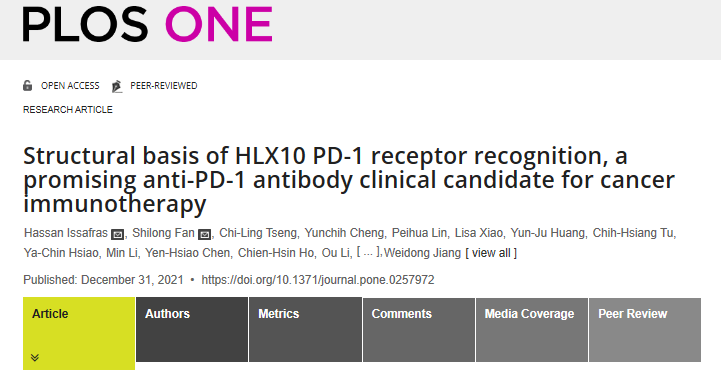独特抗原识别模式,复宏汉霖H药临床前研究及结构分析发表于PLOS ONE

H药斯鲁利单抗是复宏汉霖自主研发的人源化IgG4型抗PD-1单抗,可增强人体T细胞的肿瘤杀伤功能。体外研究显示斯鲁利单抗可增强T细胞的活化和增殖,在体内多种肿瘤模型中也展现出显著的抗肿瘤活性,并在非小细胞肺癌(NSCLC)和三阴性乳腺癌(TNBC)肿瘤模型中分别与Nivolumab和Pembrolizumab表现出相似的抑瘤效果。同时,斯鲁利单抗与贝伐珠单抗联合使用可解除PD-1/PD-L1的免疫抑制信号并抑制血管生成,在结直肠癌(CRC)和NSCLC肿瘤模型中展现出显著的抑瘤效果,为斯鲁利单抗和贝伐珠单抗联合治疗临床试验的开展奠定了基础。为了进一步探究斯鲁利单抗与PD-1的结合机制,研究者对斯鲁利单抗Fab段与PD-1复合物的晶体结构进行了解析。斯鲁利单抗与Pembrolizumab具有更相近的结合表位,两者表现出相反的重链(HC)和轻链(LC)结合方式,斯鲁利单抗的结合表面面积为445Å2(占PD-1表面的55%)。
围绕“Combওo+Global”(联合治疗+国际化)差异化开发战略,H药已获得中国、美国、欧盟等国𝓀家及地区的临床试验许可,目前共开展10项肿瘤免疫疗法临床试验,广泛覆盖肺癌、食管癌、头颈癌和胃癌等适应症。目前,斯鲁利单抗“泛癌种”治疗高度微卫星不稳定型(MSI-H)实体瘤适应症的上市注册申请(NDA)已于2021年4月获NMPA受理并被纳入优先审评审批程序,有望于2022年上半年获批上市。在肺癌一线治疗领域,斯鲁利单抗联合化疗在局部晚期或转移性鳞状非小细胞肺癌的NDA 9月获得NMPA受理;其联合化疗在既往未接受过治疗的广泛期小细胞肺癌的国际多中心III期研究于近期达到主要终点,公司将尽快提交该适应症的上市注册申请,有望成为全球首个一线治疗SCLC的抗PD-1单抗。
关于PLOS ONE
PLOS 是非营利性的开源出版商,通过引领研究领域的传播变革,使研究者能够加速科学和医学的进步。PLOS ONE 是一个包容性的期刊社区,共同努力推动科学造福社会,期刊成立旨在加速科学进步并展示其价值,相信所有严谨的科学都需要发表、发现、广泛传播。该期刊发表多学科研究成果,而且通常是跨学科的。PLOS ONE 接受科学、工程、医学以及相关社会科学和人文学科的200多个学科领域的研究,根据严谨的方法论和高道德标准来评估提交的手稿。 ꧅
关于复宏汉霖
复宏汉霖(2696.HK)是一家国际化的创新生物制药公司,致力于为全球患者提供可负担的高品质生物药,产品覆盖肿瘤、自身免疫疾病、眼科疾病等领域,已在中国上市4款产品,在欧盟上市1款产品,3个上市注册申请获得中国药监局受理。自2010年成立以来,复宏汉霖已建成一体化生物制药平台,高效及创新的自主核心能力贯穿研发、生产及商业运营全产业链。公司已建立完善高效的全球研发中🎉心,按照国际药品生产质量管理规范(꧋GMP)标准进行生产和质量管控,位于上海徐汇的生产基地已获得中国和欧盟GMP认证。
复宏汉霖前瞻性布局了一个多元化、高质量的产品管线,涵盖20多种创新单克隆抗体,并全面推进基于自有抗PD-1单抗斯鲁利单抗的肿瘤免疫联合疗法。继国内首个生物类似药汉利康®(利妥昔单抗)、中国首个自主研发的中欧双批单抗药物汉曲优®(曲妥珠单抗,欧盟商品名:Zercepac®)、汉达远®(阿达木单抗)和汉贝泰®(贝伐珠单抗)相继获批上市,创新产品斯鲁利单抗MSI-H实体瘤的上市注册申请已纳入优先审评审批程序,HLX01利妥昔单抗类风湿关节炎新适应症、斯鲁利单抗鳞状非小细胞♚肺癌适应症的上市注册申𒆙请也正在审评中。公司亦同步就11个产品、8个免疫联合治疗方案在全球范🅠围内开展20多项临床试验,对外授权全面覆盖欧美主流生物药市场和众多新兴市场。
The preclinical and structural analysis results of Henlius’ innovative anti-PD-1 mAb serplulimab, published in an international journal PLOS ONE
Recently, the preclinical study results and molecular characteristics of Henlius’ innovative anti-PD-1 monoclonal antibody (mAb) serplulimab (HLX10) were published in PLOS ONE. The results showed that compared to nivolumab and pembrolizumab, serplulimab showed similar or better bioactivity in vitro and in vivo and anti-tumor activity in several tumour models. Furthermore, serplulimab synergizes with bevacizumab biosimilar 汉贝泰 (HLX04) to promote robust tumour activity. Detailed epitope of the antigen-binding fragment (Fab) of serplulimab in complex with PD-1 analysis showed that serplulimab has a unique mode of recognition compared to the clinically approved PD-1 antibo𓆏dies pembrolizumab and nivolumab with a similar binding epitope region to pembrolizumab.
Serplulimab, a fully humanized IgG4 mAb against PD-1 receptor, increased functional activities of human T-cells. The in vitro study showed that serplulimab activates T-cell proliferation and activization. The in vivo study showed anti-tumour efficacy in several tumour models. Serplulimab showed anti-tumour efficacy similar to nivolumab in non-small cell lung cancer (NSCLC) tumour model and pembrolizumab in triple-negative breast cancer (TNBC) tumour model. The combined inhibition of PD-1/PD-L1 and angiogenesis pathways using bevacizumab HLX04 may enhance a sustained suppression of cancer-related angiogenesis and tumour elimination, and serplulimab showed favorable tumour suppressive efficacy both in colorectal cancer (CRC) and NSCLC tumour models. The results laid foundation to the clinical trials of serplulimab in combination with HLX04. To gain insight into how serplulimab achieves PD-1 recognition, scientists determined the co-crystal structure of the Fab of serplulimab in complex with PD-1 and compared this structure to the previously determined structures of pembrolizumab and nivolumab. Compared to the clinically approved PD-1 antibodies pembrolizumab and nivolumab, serplulimab has a similar binding epitope region to pembrolizumab. Serplulimab and pembrolizumab showed an opposite heavy chain (HC) and light chain (LC) usage. Serplulimab interface occupies a solvent-accessible overlapping surface area of 445Å2 (55% of PD-L1 surface) on PD-1.
Henlius has adopted a differentiated "Combo+Global" strategy on serplulimab. Currently, serplulimab has been approved for clinical trials in China, the United States, the European Union and other countries and regions. A total of 10 immuo-oncology therapies clinical trials of serplulimab are ongoing to evaluate its safety and efficacy in a wide variety of solid tumors that cover lung cancer, hepatocellular carcinoma, esophageal carcinoma, head and neck squamous cell carcinoma and gastric cancer etc. In April, the New Drug Application (NDA) of serplulimab for the treatment of MSI-H solid tumours was accepted by the NMPA and granted priority review. It is expected to be approved in the first half of 2022. In the field of first-line treatment of lung cancer, the NDA of serplulimab combined with chemotherapy in locally advanced or metastatic squamous non-small cell lung cancer was accepted by NMPA in September. The international multi-center Phase 3 study of serplulimab in combination with chemotherapy in previously untreated extensive smal🐽l-cell lung cancer recently reached the primary endpoint. Henlius will proceed to file the regulatory applications for this indication as soon as possible. It is expected to be the first anti-PD-1 mAb for first-line treatment of SCLC.
AboutPLOS ONE
PLOS is a nonprofit, Open Access publisher empowering researchers to accelerate progress in science and medicine by leading a transformation in research communication. PLOS ONE is an inclusive journal community working together to advance science for the benefit of society, now and in the future. Founded with the aim of accelerating the pace of scientific advancement and demonstrating its value, PLOS ONE believes all rigorous science needs to be published and discoverable, widely disseminated and freely accessible to all. The research of PLOS ONE publish is multidisciplinary and, often, interdisciplinary. PLOS ONE accepts research in over two hundred subject areas across science, engineering, medicine, and the related social sciences and humanities. PLOS ONE evaluates submitted manuscripts on the basis of methodo⛄logical rigor and high e🍎thical standards.
About Henlius
Henlius (2696.HK) is a global biopharmaceutical company with the vision to offer high-quality, affordable and innovative biologic medicines for patients worldwide with a focus on oncology, autoimmune diseases and ophthalmic diseases. Up to date, 4 products have been launched in China, 1 in the European Union (EU), 3 New Drug Applications (NDAs) accepted for review in China. Since its inception in 2010, Henlius has built an integrated biopharmaceutical platform with core capabilities of high-efficiency and innovation embedded throu𝐆ghout the whole product life cycle including R&D, manufacturing and comꦅmercialisation. It has established global R&D centres and a Shanghai-based manufacturing facility certificated by China and the EU Good Manufacturing Practice (GMP).
Henlius has pro-actively built a diversified and high-quality product pipeline covering over 20 innovative monoclonal antibodies (mAbs) and has continued to explore immuno-oncology combination therapies with proprietary serplulimab (anti-PD-1 mAb) as backbone. Apart from the launched products 汉利康® (rituximab), the first China-developed biosimilar, 汉曲优® (trastuzumab, Zercepac® in the EU), the first China-developed mAb biosimilar approved both in China and in the EU, 汉达远® (adalimumab) and 汉贝泰® (bevacizumab), the NDA of innovative product serplulimab indicated for MSI-H solid tumors has been granted priority review, and the NDAs of HLX01 (rituximab) for the treatment of rheumatoid arthritis and serplulimab for the treatment of squamous non-small cell lung cancer are also under review. What's more, Henlius has conducted over 20 clinical studies for 11 products and 8 combination therapies worldwide, expanding its presence 𒈔in major market as well as emerging market.
联系方式
媒体:PR@Henlius.com
投资者:IR@Henlius.com
【参考文献】
Issafras H, Fan S, Tseng C-L, Cheng Y, Lin P, Xiao L, et al. (2021) Structural basis of HLX10 PD-1 receptor recognition, a promising anti-PD-1 antibody clin𒁃ical candidate for cancer immunotherapy. PLoS ONE 16(12): e0257972. //doi.org/10.1371/journal.pone.0257972


